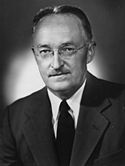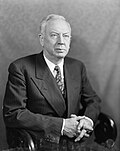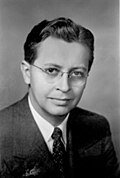| ||||||||||||||||||||||||||||||||||||||||||||||||||||||||||||||||||||
36 of the 96 seats in the United States Senate 49 seats needed for a majority | ||||||||||||||||||||||||||||||||||||||||||||||||||||||||||||||||||||
|---|---|---|---|---|---|---|---|---|---|---|---|---|---|---|---|---|---|---|---|---|---|---|---|---|---|---|---|---|---|---|---|---|---|---|---|---|---|---|---|---|---|---|---|---|---|---|---|---|---|---|---|---|---|---|---|---|---|---|---|---|---|---|---|---|---|---|---|---|
| ||||||||||||||||||||||||||||||||||||||||||||||||||||||||||||||||||||
 | ||||||||||||||||||||||||||||||||||||||||||||||||||||||||||||||||||||
| ||||||||||||||||||||||||||||||||||||||||||||||||||||||||||||||||||||
The 1946 United States Senate elections were held November 5, 1946, in the middle of Democratic President Harry S. Truman's first term after Roosevelt's passing. The 32 seats of Class 1 were contested in regular elections, and four special elections were held to fill vacancies. The Republicans took control of the Senate by picking up twelve seats, mostly from the Democrats. This was the first time since 1932 that the Republicans had held the Senate, recovering from a low of 16 seats following the 1936 Senate elections.
Contents
- Results summary
- Gains, losses, and holds
- Retirements
- Defeats
- Post election changes
- Change in composition
- Before the elections
- Election results
- Race summaries
- Special elections during the 79th Congress
- Races leading to the 80th Congress
- Closest races
- Alabama (special)
- Arizona
- California
- California (special)
- California (regular)
- Connecticut
- Connecticut (regular)
- Connecticut (special)
- Delaware
- Florida
- Idaho (special)
- Indiana
- Kentucky (special)
- Maine
- Maryland
- Massachusetts
- Michigan
- Minnesota
- Mississippi
- Missouri
- Montana
- Nebraska
- Nevada
- New Jersey
- New Mexico
- New York
- North Dakota
- North Dakota (regular)
- North Dakota (special)
- Ohio
- Ohio (special)
- Ohio (regular)
- Pennsylvania
- Rhode Island
- Tennessee
- Texas
- Utah
- Vermont
- Virginia
- Virginia (regular)
- Virginia (special)
- Washington
- West Virginia
- Wisconsin
- Wyoming
- See also
- Notes
- References
The vote was largely seen as a referendum on Truman, whose approval rating had sunk to 32% [1] over the president's controversial handling of a wave of post-war labor strikes, such as a nationwide railroad strike in May, at a time when Americans depended on train service for both commuter and long-distance travel. Just as damaging was Truman's back-and-forth over whether to end unpopular wartime price controls to handle shortages, particularly in foodstuffs. For example, price controls on beef had led to a "hamburger famine," but when Truman, in a surprise move, lifted the controls on October 14—just weeks before the election—meat prices shot up to record levels.[ citation needed ]
This is only one of two occasions in U.S. history that 10 or more Senate seats changed hands in a midterm election (the other being in 1958), and also one of five occasions where 10 or more Senate seats changed hands in any election, with the other occasions being in 1920, 1932, 1958, and 1980.
The president's lack of popular support is widely seen as the reason for the Democrats' congressional defeat, the largest since they were trounced in the 1928 pro-Republican wave that brought Herbert Hoover to power. [2] [3] And for the first time since before the Great Depression, Republicans were seen as the party which could best handle the American economy.
However, the Republicans also benefited from what today would be called "a good map," meaning that of the one-third of Senate seats up for election, the majority were held by Democrats. Besides the Republicans being able to hold onto all of their seats, this was the party's largest senate gain since 1920.








































































































